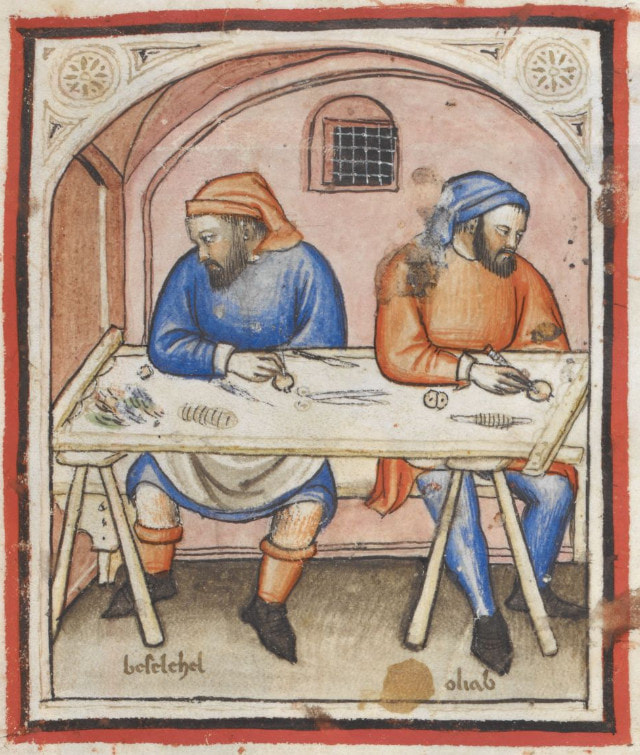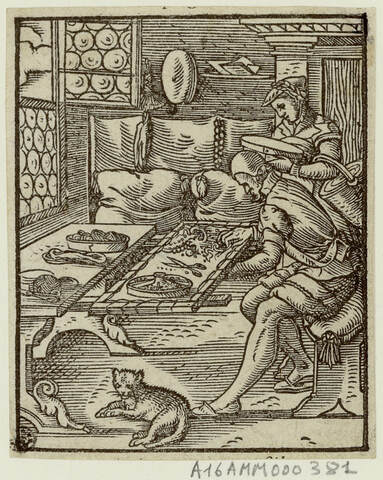|
As I was studying a Portuguese book on medieval embroidery, I came across an article by José Alberto Seabra Carvalho on the craft of embroidery in the Middle Ages and Early Modern period. Although he acknowledged that some embroidery was undertaken by the women in noble households and by nuns in convents, he also came to the conclusion, by studying the surviving pieces and combining them with the historical records, that those were made by men in commercially run workshops. Their quality is simply too high. It requires many years of training before one is able to make a living from making orphreys. At the same time, he briefly investigates this ideal of the 'pious woman'. As long as her hands were busy doing needlework, she could not daydream and get into trouble. In addition, her handy work could contribute a bit to the household. These opinions are not his but come from contemporary sources. And here we have precisely this duality: needlework itself is not much valued as it is done by women to keep them from having a wandering mind. While at the same time, commercially produced goldwork embroidery requires many years of training and is thus the domain of men. The duality and stigma embroidery 'enjoys' today is thus an old one. Art versus craft. And only for women. Let's explore what that looks like in medieval and early modern images! Female embroiderers are depicted in two different ways: stitching in hand or sitting behind a slate frame resting on trestles. Usually, it is not ordinary women that are depicted embroidering. Especially not in the earlier periods. It is either Mary employing a needle or a queen/noblewoman stitching. Stitching in hand requires very little in terms of professional tools. Mary on the left has a simple basket filled with scissors and a bobbin with thread. This is in strong contrast to Joseph's array of professional carpenter tools hanging on the wall. By the way: I don't think St Francis would approve of Jesus tying a rope to a bird :). Contrary, Mary on the right, is shown in a much more professional setting. She uses a large slate frame and a pair of trestles. The spool she is holding might be wound with gold thread. It looks like she is using her slate frame and trestles set-up as a kind of working table with balls of yarn laying on top. Some people argue that this shows Mary making a tapestry instead of an embroidery. However, I think she is in the process of couching down a gold thread on top of red and green silk embroidery. In both images, combining embroidery with childcare seems not to be a problem. Maybe that's why the child is harassing the bird? Male embroiderers, on the other hand, are depicted in one way only. As professionals. No cosy stitching whilst watching a child. Maybe medieval and early modern men were just not prone to 'daydreaming and getting into trouble'?
The above illustrations show men sitting behind slate frames in the typical posture of an embroiderer. One hand above the frame and one hand below to speed up the process. And I love the non-ergonomic posture of the man on the right. At least none of the above men can be told off for crossing their legs :). By the way, I think we also see very realistic depictions of how these professional workshops were set up back in the day. The men on the left are probably working outside under a portico. Maximal use of daylight, but a bit sheltered from the weather conditions. The man on the right has the luxury of window glass. But he still needs to sit right in front of them and even needs to open the top window for clear, unfiltered daylight. The stereotypes depicted in the above images, some over 600 years old, seem to persist today. When I am demonstrating professional goldwork embroidery at my local open-air museum I get many stereotypical reactions. Many women equate what I am doing with cross-stitch embroidery. And when they hear that this is not my hobby, but my profession, I get 'the look'. It is not a kind look :). Some even react very irritated. How can a woman, who has gone successfully through university, want to stitch for a living?! How on earth did I sink so low? Very few women admit that they themselves stitch. And the ones that do, get younger from year to year. So, there is hope! Many men, on the other hand, have a very different reaction. They univocally acknowledge that what I am doing is very different from the needlework their mums and wives did or do. They are interested in my tools and the mechanics of it all. Some remark that this is 'typical' women's work. When I then explain that this was a male profession for hundreds of years, I have their full attention. Some even ask if I personally know male embroiderers (Gary Parr, you are getting famous here in Bavaria!). A few are so intrigued, they revisit the museum and seek me out to see how the work has progressed. And as they can precisely point out what I had accomplished last time, it is clearly about the embroidery and not about me :). I really hope that some people who see me stitch in the museum pick up a needle. Regardless of their reaction. Embroidery is fun! The ancient forms should be studied and revived. The professionalism of the makers should be acknowledged and valued. I hope you liked this blog post. Maybe it can contribute a bit of 'fact' to the craft versus art debate. Knowing that we are repeating the medieval and early modern idea of the 'ideal woman' when we see embroidery solely as a craft (in the modern sense), might make people think twice before they argue their case. The above images are not the only ones I have collected over the years. My valued Journeyman and Master Patrons will have access to a Padlet with 10 additional images. Literature Seabra Carvalho, J.A., 1993. O Ofício. In: T. Alarcão & J. A. Seabra Carvalho (eds), Imagens em paramentos bordados seculos XIV a XVI, Instituto Portugues Museus, p. 16-21.
14 Comments
Cynthia Jackson
17/4/2023 14:30:47
Hi Jessica
Reply
17/4/2023 15:11:16
LOL. I am thinking of secretly filming some people. My other favourite one is: have YOU made this? The amount of disbelief in that remark is almost physical.
Reply
Marina
17/4/2023 15:15:43
Lol - 'the look' ! Oh yes,do I know 'the look' ! When I demonstrated Blackwork/ Goldwork during the Journées européennes des Métiers d'Art (European Days of Art Trades) in 2014 and 2015, I was told by most visitors that anybody could do exactly the same thing as me. They clearly did not understand that I was doing something else than cross-stitch and did not even bother to look properly. Men were not much more interested than women, and I got 'the look' from them all, even from fellow artisans. Once, a man and his wife came over with angry expressions on their faces, demanding me to explain what I was doing. So I stitched, demonstrated and explained, and when I raised my head to look at them, they were gone! And to sum things up, I never gained one single student from those demonstrations.
Reply
17/4/2023 15:27:54
The museum setting seems to make a difference. For many years, I demonstrated at the Pilatushaus in Oberammergau with other artisans. That was plain horror. Almost nobody was nice. I was constantly ridiculed and there was very little interest in what I was actually doing. And I must admit, in high-summer, the crowd at the museum changes a bit too :(.
Reply
Hazel Conway
17/4/2023 16:40:21
Hello Jessica, I always enjoy your posts but this was specially interesting. Thank you for all your research.
Reply
17/4/2023 17:19:57
Thank you, Hazel! And I am glad you liked my post.
Reply
Kristi Nowak
17/4/2023 17:47:45
Dear Jessica,
Reply
17/4/2023 20:43:36
How lovely to hear from you, Kristi! And I am glad that you found my post interesting.
Reply
17/4/2023 20:44:59
Indeed, Rachel. I love it when people gather around my frame and we have a nice conversation about what I am doing!
Reply
23/4/2023 14:56:31
That’s so interesting, Alicia. The ‘advantage’ of doing goldwork embroidery is that it can’t yet be done by a machine 😉
Reply
Tori Owen
13/5/2023 19:39:10
Fascinating information! We just spent a month in India on a textile tour and fell in love with their embroidery. Fascinating to see the European version. Going to try to visit those textile museums in Northern Italy in September. Thank you for all of your research!
Reply
Your comment will be posted after it is approved.
Leave a Reply. |
Want to keep up with my embroidery adventures? Sign up for my weekly Newsletter to get notified of new blogs, courses and workshops!
Liked my blog? Please consider making a donation or becoming a Patron so that I can keep up the good work and my blog ad-free!
Categories
All
Archives
July 2024
|
Contact: info(at)jessicagrimm.com
Copyright Dr Jessica M. Grimm - Mandlweg 3, 82488 Ettal, Deutschland - +49(0)8822 2782219 (Monday, Tuesday, Friday & Saturday 9.00-17.00 CET)
Impressum - Legal Notice - Datenschutzerklärung - Privacy Policy - Webshop ABG - Widerrufsrecht - Disclaimer
Copyright Dr Jessica M. Grimm - Mandlweg 3, 82488 Ettal, Deutschland - +49(0)8822 2782219 (Monday, Tuesday, Friday & Saturday 9.00-17.00 CET)
Impressum - Legal Notice - Datenschutzerklärung - Privacy Policy - Webshop ABG - Widerrufsrecht - Disclaimer










 RSS Feed
RSS Feed